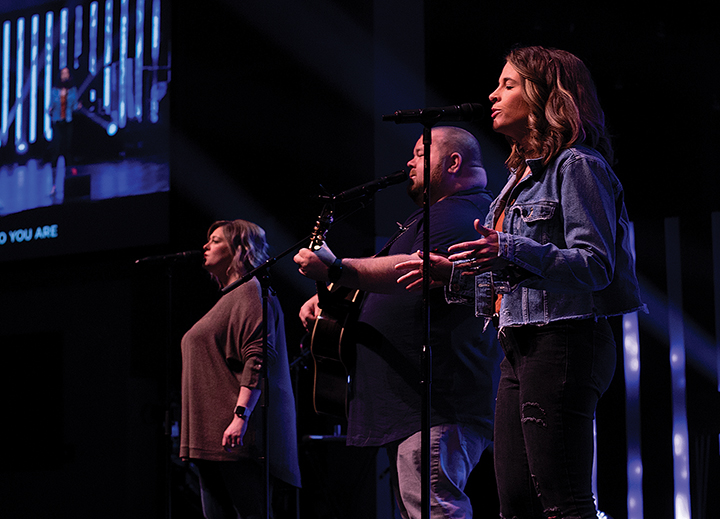
How a large church quickly — and easily — streamlined multiple software applications into one all-purpose tool for maximum efficiency
By RaeAnn Slaybaugh
Photos by Luis Morera
It’s a common scenario in many churches: those who choose the various software applications do so because they provide a specific functionality. The result: inefficiency.
TrueNorth Church in North Augusta, SC, was no exception.

As Business and Operations Director Tim Gamache explains, the church was using one application for its small-groups ministry; another for services planning and management; and a third for volunteer management. Additionally, a payment processing platform was in use at the church.
As a result, TrueNorth was using each tool for a specific functionality — but not optimizing every available function.
So, in late 2019 and early 2020, church leaders aimed once and for all to streamline all these functionalities into a single platform.
Previously, Gamache and the church’s Pastor of Ministries met Churchteams Co-founder Boyd Pelley at a small groups conference and became friends. Gamache suggested that the leadership team reach out to Pelley and share their objectives for TrueNorth. A proposal was requested, and the rest, as they say, is history.
But, what made this tool the best fit for TrueNorth among so many well-known options? That’s its own story.
Necessity: the mother of invention
Leaders at TrueNorth were facing particularly significant inefficiencies when it came to database management.
“If we wanted to send out a church-wide communication, we had to manually collect contact information from every application we were using, manually eliminate redundant information, and manually import the data into our email application for sending,” Gamache says. “Those inefficiencies manifested themselves not only in communication, but any time we needed to reference our church family database for any purpose.”
Now, with Churchteams, they are able to filter recipients by dozens of criteria, which lets them laser-focus their email communications. This efficiency is crucial, especially when sending year-end contribution statements, for example.
“We used to manually print, package, address and send every statement at the beginning of every year,” Gamache says. “For the past two years, we have processed automated email contribution statements, which has saved time, money and effort.”

T2C is top of mind
The application’s text-to-church functionality was particularly attractive, as well — and something Gamache and 32 other staff members, ministry leads and volunteers at TrueNorth now use often. According to Gamache, this “fantastic” tool is used for all event registration, as well as for giving, connection with first-time guests, prayer requests, and small group inquiries (to name just a few).
“Everything we do as a church that requires connection with our church family is initiated through text-to-church,” he says. “It has been a game-changer.”

Volunteer management made eas(ier)
Additionally, TrueNorth’s adoption of the Churchteams platform contributed to the development of a new volunteer module — an essential tool for a large church with a healthy volunteer base.
The consensus among ministry leads is that this module has greatly enhanced their ability to manage volunteers for both weekly ministry events and for special events, according to Gamache.
“It also makes the recruitment of new volunteers extremely easy and efficient,” he adds. “A person interested in volunteering merely has to text ‘serve’ to our church number and they receive a link to complete a form to sign up to volunteer in any of our ministry areas.”
Even better, if the person is already in the church’s database, that form is pre-filled with all his or her pertinent personal information.

It actually does come easy…
The ease with which the church’s data was transitioned to the Churchteams platform was another selling point, according to Gamache. This was especially important since the switch-over would need to happen during the Coronavirus pandemic — which actually proved to be great timing.
“When COVID hit and we were forced to shut down our in-person services, we knew we didn’t need children check-ins, volunteer management, or other Sunday services-related functionality,” he explains. “So, we could make the transition and become comfortable with the software without a lot of pressure.”
Given the unique circumstances, Gamache says he and his team immediately familiarized themselves with the online giving functionality. They then communicated to the church family that they were still fully engaged with the ministry and appreciated their continued faithful giving, even in the absence of in-person worship.
“During that time, our online giving method became about 75 percent of our total giving!” Gamache points out. And that percentage endures, today.
During the actual transition, Gamache says very specific instructions were provided regarding all the information Churchteams needed from TrueNorth, so all that was required of Gamache and his team, in terms of data, was clearly defined.
Once the transition was complete, video-based (Zoom and Knowledge Base) and in-person training were provided to ensure church staff and volunteers could get answers to any questions that lingered.
“When we transitioned back to in-person services, our entire staff was very comfortable with Churchteams’ services and events functionality,” Gamache adds. “So, it was nearly seamless.”
Partnership prevails
In the end, Gamache says that the level of customer service provided — plus, functionality and cost — made Churchteams the best possible fit for TrueNorth.
“To this day, we can call any member of their team, including [Pelley], and discuss what we need from the software,” he adds. “They either walk us through existing functionality to meet our needs or, if we have an idea that will benefit all users, they incorporate it into the application.
“Our church is extremely focused on relationships,” Gamache concludes. “Churchteams has proven to be focused on their relationships with their users, as well.”


